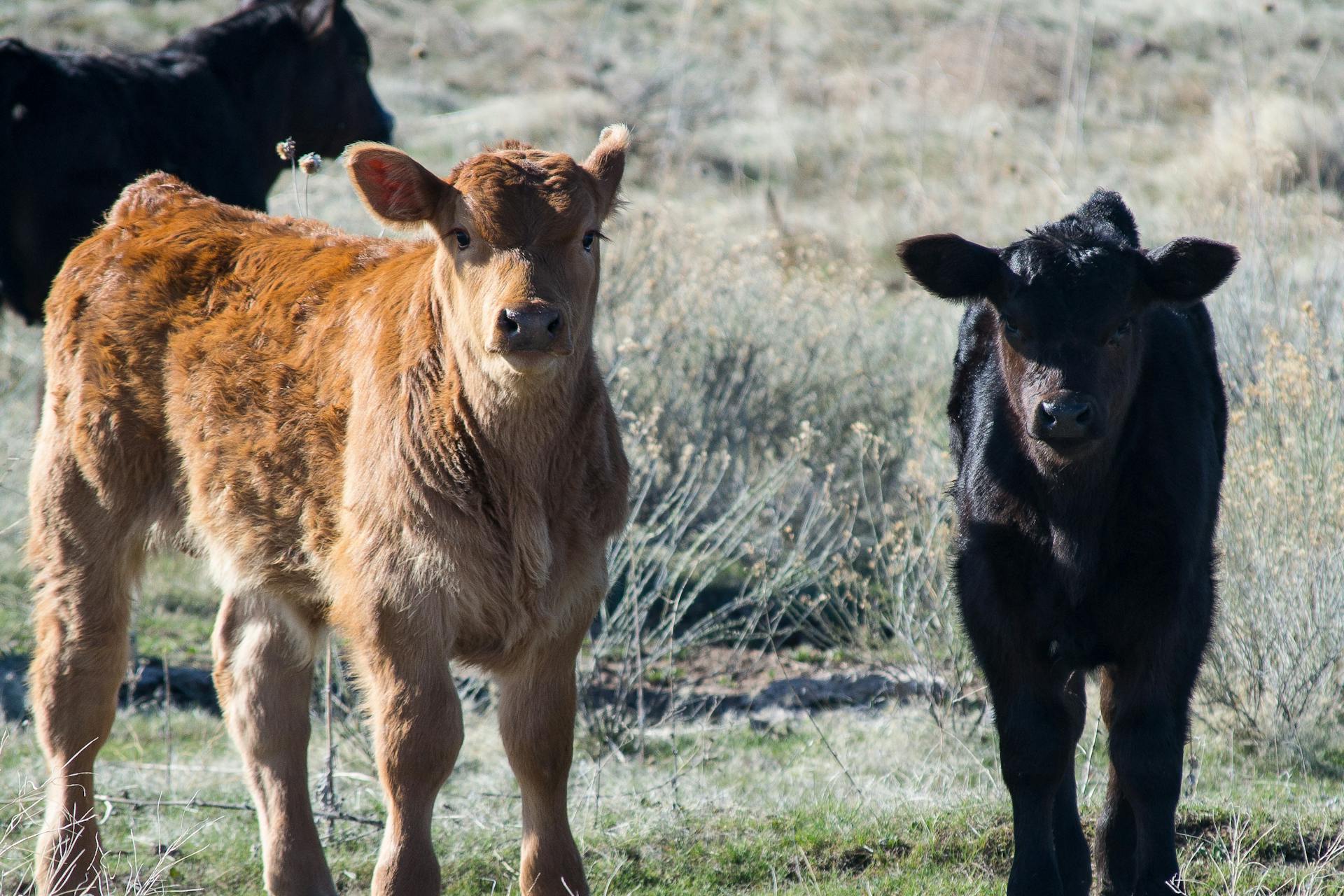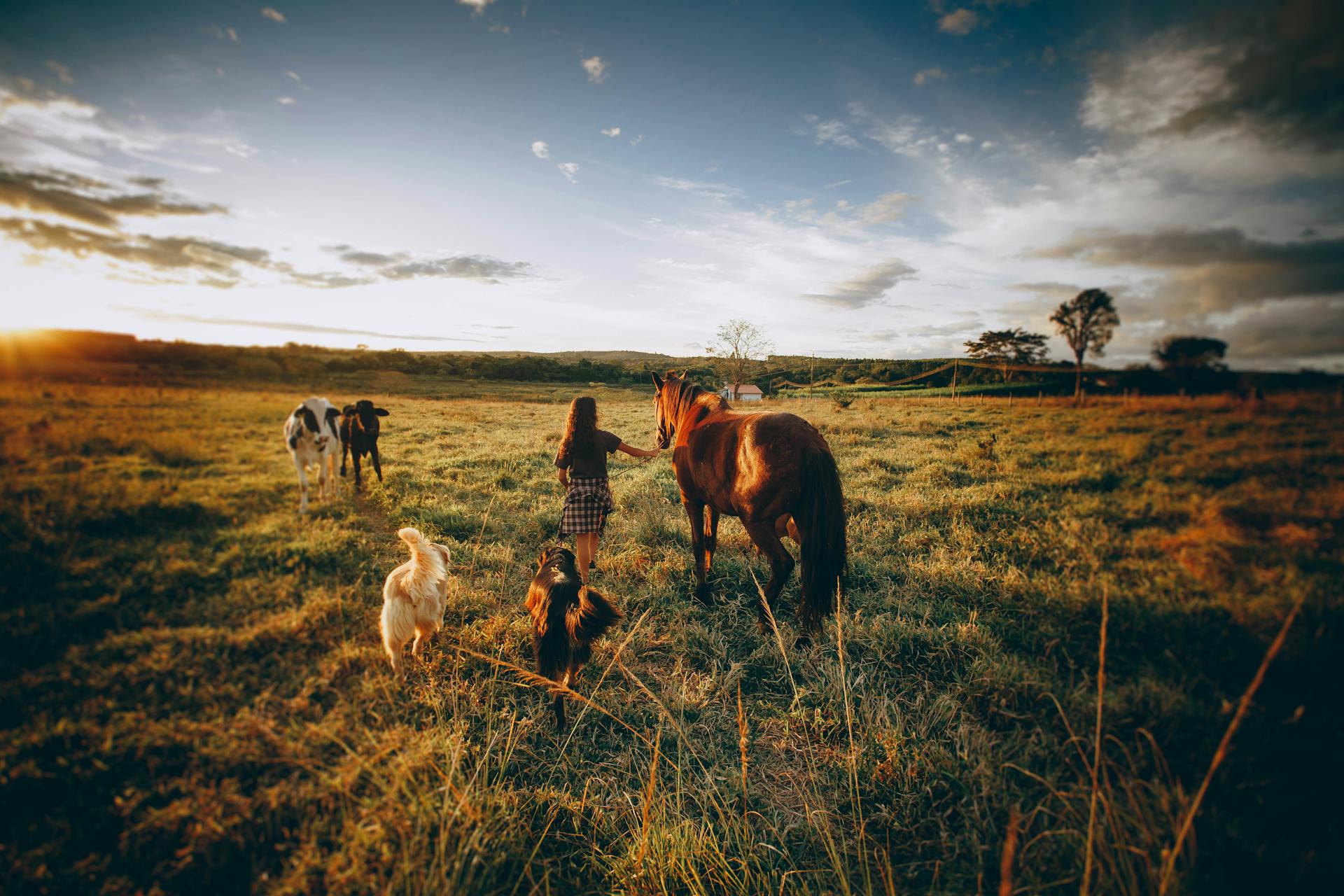
There are several types of cattle dogs, each with their own unique characteristics and traits. The Australian Cattle Dog, for example, is a highly energetic breed that requires regular exercise and mental stimulation.
This breed was originally developed in Australia in the 19th century to herd cattle and other livestock. Their strong work ethic and intelligence made them an ideal choice for this task.
The Blue Heeler is a popular variation of the Australian Cattle Dog, known for its distinctive blue-gray coat. They are highly intelligent and trainable, but can be strong-willed at times.
In contrast, the Red Heeler is a variation of the Australian Cattle Dog with a reddish-brown coat. They are known for their high energy levels and require regular exercise to stay happy and healthy.
Expand your knowledge: How Much Exercise Do Border Collies Need
Australian Cattle Dog Basics
The Australian Cattle Dog is a compact but muscular dog breed. They are also known as Blue or Red Heelers or Queensland Heelers.
The Australian Cattle Dog, in particular, is one of the most popular dog breeds. They are a tough and lean ranch dog.
This breed is a great example of an "only in America" story, but they actually originated in Australia.
Coat and Colour
The Australian Cattle Dog's coat comes in two accepted colours: red and blue. Both colours are the result of the ticking gene, which causes black or red hairs to appear through a predominantly white coat.
Red dogs are evenly speckled with solid red markings, and can have a brown patch "mask" on one or both sides of the head and sometimes on the body. They're born white, with the red hairs showing from around four weeks of age.
Blue dogs can be blue, blue mottled, or blue speckled with tan on the legs and chest, and a black patch or "mask" on one or both sides of the head. They also have a distinctive adult colouration.
The distinctive adult colouration is the result of black or red hairs closely interspersed through a predominantly white coat. This is not merle colouration, but rather the result of the ticking gene.
Both red and blue dogs have a double coat, with short, straight outer guard hairs that protect the skin from the elements. The undercoat is short, fine, and dense.
The mask consists of a black patch over one or both eyes for blue coat colour, or a red patch over one or both eyes for red coat colour. Dogs without a mask are called plain-faced, and are also acceptable according to the breed standard.
Readers also liked: Bull Terrier Head Shape
Size
The Australian Cattle Dog is a medium-sized breed, with females measuring approximately 43-48 centimetres at the withers.
In terms of height, the female Australian Cattle Dog is relatively short, with males being slightly taller, measuring about 46-51 centimetres at the withers.
The ideal body shape of an Australian Cattle Dog is one where the length of the body is greater than the height at the withers, in a ratio of 10 to 9.
Australian
The Australian Cattle Dog is a compact but muscular breed.
This breed is also known as the Blue or Red Heeler.
The Australian Cattle Dog is a popular dog breed.
It's one of those 'only in America' stories: a breed that originated in another country.
The Australian Cattle Dog is a lean, tough ranch dog.
Temperament and Training
The Australian Cattle Dog is a high-energy breed that needs plenty of exercise, companionship, and a job to do. It's not suited for a sedentary lifestyle, so be prepared to engage its body and mind with activities like dog sports, learning tricks, or other fun activities.
This breed is highly intelligent, ranking 10th in Stanley Coren's The Intelligence of Dogs, making it a great candidate for obedience training. With consistent and varied training, you can tap into its biddable nature and responsiveness.
However, the Australian Cattle Dog can be reserved with strangers and naturally cautious in new situations, making it an excellent guard dog when trained for this task. It's essential to socialize your Cattle Dog from an early age to help it become accustomed to various people and situations.
Temperament
The Australian Cattle Dog has high energy levels and a strong will to please, making it an excellent breed for obedience training.
This breed ranks 10th in Stanley Coren's The Intelligence of Dogs, indicating its exceptional intelligence and trainability.
The Cattle Dog needs plenty of exercise and mental stimulation to prevent boredom and frustration, which can lead to barking or destructive behavior.
It's essential to provide this breed with a job to do, such as participating in dog sports or learning tricks, to keep them engaged and happy.
The Australian Cattle Dog is naturally cautious in new situations and reserved with people it doesn't know, making it an excellent guard dog when trained for this task.
However, with proper socialization from an early age, this breed can become accustomed to a variety of people and make a wonderful family pet.
It's crucial to teach children how to interact with the Australian Cattle Dog, as they may herd people by nipping at their heels, especially if they're young and energetic.
By training your Australian Cattle Dog to respond to cues and rewarding good behavior, you can create a strong and loving bond with your dog.
Training
The Australian Cattle Dog is a highly intelligent breed that responds well to training, especially when a structured and varied program is used.
This intelligence can be both an advantage and a disadvantage, as it can lead to unwanted outcomes if training is not consistent or is repetitive and boring for the dog.
The breed is biddable, meaning it is responsive to training and willing to learn, which makes it a great choice for first-time dog owners.
Consistency is key when training an Australian Cattle Dog, as it can get bored with repetitive and unchanging exercises.
A well-structured training program can help to bring out the best in this breed and make the training process more enjoyable for both the dog and the owner.
Frequently Asked Questions
What is the toughest cattle dog?
The Australian Cattle Dog is a rugged breed known for its intelligence and high energy level, requiring a firm hand to manage its independent and headstrong nature. This breed excels in physical and mental challenges, making it a popular choice for active owners.
What is the difference between a heeler and a cattle dog?
There is no difference between a Heeler and a Cattle Dog, as they are the same breed. The terms are often used interchangeably, but some Cattle Dogs may be referred to as Heelers based on their coat color.
What dogs are good for herding cattle?
Australian Cattle Dogs, also known as "heelers", are well-suited for herding cattle due to their powerful herding instincts and compact build. They excel at quickly and efficiently moving livestock around the ranch or range.
What is the best cattle dog?
The Australian Cattle Dog is a top breed for cattle work due to its exceptional intelligence and trainability. Known as "Heelers," this breed excels at herding cattle and sheep with ease.
What breeds make an Australian Cattle Dog?
Australian Cattle Dogs are a cross between Dingoes and various breeds, including Collies, Dalmatians, and Kelpies. Their unique ancestry is a result of early breeding experiments by Thomas Simpson Hall in 1840.
Featured Images: pexels.com


